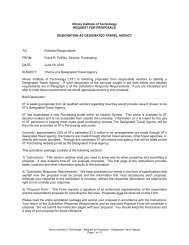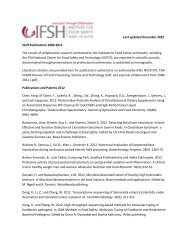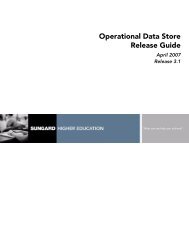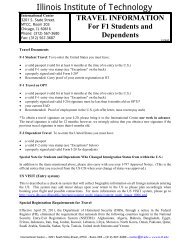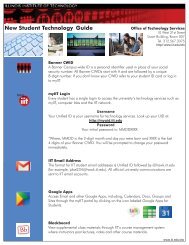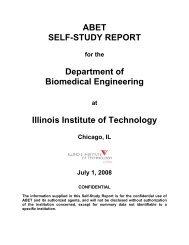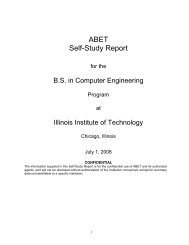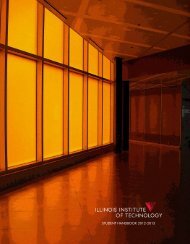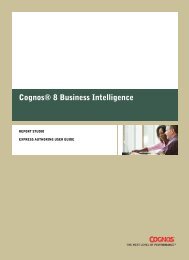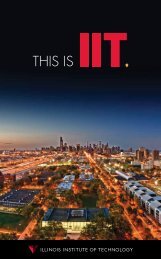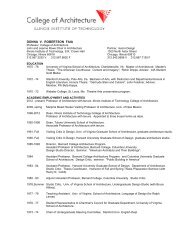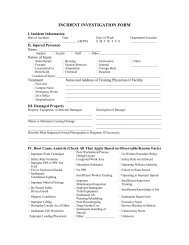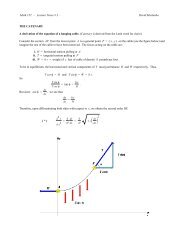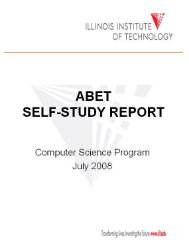Copyright & Disclaimer Information - Illinois Institute of Technology
Copyright & Disclaimer Information - Illinois Institute of Technology
Copyright & Disclaimer Information - Illinois Institute of Technology
Create successful ePaper yourself
Turn your PDF publications into a flip-book with our unique Google optimized e-Paper software.
156<br />
Course Descriptions<br />
BME 460<br />
Advanced Biomaterials<br />
Continuation <strong>of</strong> biomaterials applications<br />
to tissue and organs. Novel<br />
applications <strong>of</strong> materials to replace<br />
living tissues and organs, such as<br />
skin, blood vessels and heart valves<br />
will be considered. Prerequisite:<br />
BME 310. (3-0-3)<br />
BME 470<br />
Engineering Biocompatible Materials<br />
This course aims to describe synthetic<br />
materials that are routinely used<br />
as components <strong>of</strong> various medical<br />
devices implanted in the human body.<br />
Students will critically examine prosthetic<br />
materials used in specific<br />
devices. The biological environment<br />
relevant to the discussed implant will<br />
be reviewed. Problems with current<br />
materials will be analyzed. Strategies<br />
and techniques required to engineer<br />
sophisticated biomaterials for future<br />
applications will be developed.<br />
Prerequisites: BIOL 107, BIOL 109,<br />
BIOL 115, BIOL 117. (3-0-3) (C)<br />
BME 475<br />
Neuromechanics <strong>of</strong> Human Movement<br />
Concepts from mechanics and neurophysiology<br />
will be introduced and<br />
employed to analyze and model<br />
human movement, especially <strong>of</strong> the<br />
extremities. Topics will include forward<br />
and inverse kinematics and<br />
dynamics, muscle modeling, and<br />
feedback control. Prerequisites: BME<br />
330, BIOL 115. (3-0-3)<br />
BME 482<br />
Mass Transport for Biomedical Engineers<br />
This course seeks to provide students<br />
with an introduction to advanced<br />
concepts <strong>of</strong> mass transport with an<br />
emphasis on biological systems.<br />
Students will be exposed to derivation<br />
<strong>of</strong> the conservation equations for<br />
heat, mass, and momentum.<br />
Following derivation <strong>of</strong> these laws,<br />
focus will be placed on mass transport<br />
applications, including diffusion,<br />
convection-diffusion, diffusion with<br />
reactions, and facilitated diffusion.<br />
Students will be able to apply mass<br />
transport equations to solve problems<br />
in biological systems.<br />
Prerequisites: CHE 202, BME 301.<br />
(3-0-3)<br />
<strong>Copyright</strong> & <strong>Disclaimer</strong> <strong>Information</strong>: <strong>Copyright</strong> © 1994, 1995, 1996, 1997, 1998, 1999, 2000, 2001, 2002, 2003, 2004, 2005, 2006, 2007. CollegeSource®, Inc. and Career Guidance Foundation. CollegeSource® digital catalogs are derivative works owned and copyrighted by CollegeSource®, Inc. and Career Guidance Foundation. Catalog content is owned and copyrighted by the appropriate school. While CollegeSource®, Inc. and Career Guidance Foundation provides information as a service to the public, copyright is retained on all digital catalogs.<br />
<strong>Copyright</strong> & <strong>Disclaimer</strong> <strong>Information</strong>: <strong>Copyright</strong> © 1994, 1995, 1996, 1997, 1998, 1999, 2000, 2001, 2002, 2003, 2004, 2005, 2006, 2007. CollegeSource®, Inc. and Career Guidance Foundation. CollegeSource® digital catalogs are derivative works owned and copyrighted by CollegeSource®, Inc. and Career Guidance Foundation. Catalog content is owned and copyrighted by the appropriate school. While CollegeSource®, Inc. and Career Guidance Foundation provides information as a service to the public, copyright is retained on all digital catalogs.<br />
BME 490<br />
Senior Seminar<br />
Pr<strong>of</strong>essional issues in bioengineering.<br />
Role <strong>of</strong> bioengineers in industry.<br />
Pr<strong>of</strong>essional identity. Structure <strong>of</strong><br />
bioengineering industries and product<br />
development process. Job market<br />
analysis. Current employment opportunities.<br />
Recruiting process and<br />
interview. Analysis <strong>of</strong> the employer.<br />
Marketing versus engineering.<br />
Management by objective. Role <strong>of</strong><br />
higher degrees. (1-0-1) (C)<br />
BME 491<br />
Independent Study<br />
Focused reading and study under the<br />
supervision <strong>of</strong> a BME faculty member.<br />
A final written report is required<br />
to receive credit. Prerequisite:<br />
Consent <strong>of</strong> instructor. (Credit: 1-3<br />
credit hours) (C)<br />
BME 492<br />
Undergraduate Research<br />
Independent research (experimental<br />
or theoretical/computational) under<br />
the supervision <strong>of</strong> a BME faculty<br />
member. A final written report is<br />
required to receive credit.<br />
Prerequisite: Consent <strong>of</strong> instructor.<br />
(Credit: 1-3 credit hours) (C)<br />
Business<br />
BUS 100<br />
Introduction to the Pr<strong>of</strong>ession<br />
Introduction to business as a pr<strong>of</strong>ession.<br />
Topics include the role <strong>of</strong> business<br />
in our society, career opportunities<br />
in business, the interface<br />
between business and technology,<br />
business ethics, and communication<br />
skills. (1-2-2) (C) (E)<br />
BUS 205<br />
Business Basics<br />
The course will provide a basic introduction<br />
to accounting and marketing<br />
principles, two <strong>of</strong> the core business<br />
skills that every entrepreneur, engineer,<br />
or scientist involved with new<br />
product introduction needs. It is<br />
intended for engineering, science and<br />
architecture students who are not<br />
taking a business minor. This course<br />
would not count towards a business<br />
degree or business minor. (3-0-3)<br />
IIT Undergraduate Bulletin 2006–2008<br />
BUS 210<br />
Financial and Managerial Accounting<br />
Basic financial and managerial<br />
accounting topics: GAAP, the major<br />
financial statements, accrual<br />
accounting, financial reporting alternatives,<br />
financial statement analysis,<br />
cost behavior, cost systems, shortand<br />
long-term decision-making and<br />
product costing. Formerly ACCT 151.<br />
(3-0-3)<br />
BUS 211<br />
Financial Accounting and External Reporting<br />
Introduces the three major financial<br />
statements: The Balance Sheet, the<br />
Income Statement, and the<br />
Statement <strong>of</strong> Cash Flows. The course<br />
emphasizes the difference between<br />
cash flows and income. Emphasis is<br />
placed on understanding financial<br />
statements and the procedures<br />
underlying them rather than on the<br />
preparation <strong>of</strong> such statements.<br />
Accounting s<strong>of</strong>tware will be used to<br />
facilitate the preparation <strong>of</strong> statements.<br />
(3-0-3) (E)<br />
BUS 212<br />
Managerial Accounting and Control<br />
The sequel to BUS 211, this course<br />
concentrates on the uses <strong>of</strong> accounting<br />
information within an enterprise<br />
for the following purposes: product<br />
costing; short-term and long-term<br />
decision-making; budgeting; control<br />
<strong>of</strong> operations; and performance evaluation.<br />
The major topical areas covered<br />
are cost-volume-pr<strong>of</strong>it relationships,<br />
relevant costs, cash flow forecasts,<br />
flexible budgets and standard<br />
costs. Prerequisite: BUS 211. (3-0-3)<br />
BUS 221<br />
Statistics for Managerial Decision Making<br />
Introduction to probability concepts;<br />
descriptive statistics; probability distributions<br />
(binomial, Poisson, normal<br />
and t) and their applications.<br />
Statistical inference (confidence<br />
intervals, hypothesis testing and<br />
sample size determination); simple<br />
regression and correlation.<br />
(3-0-3)



